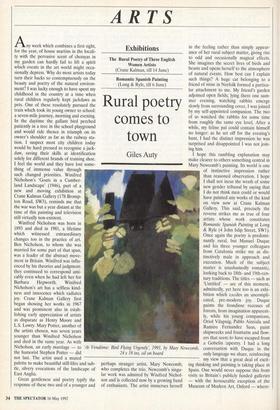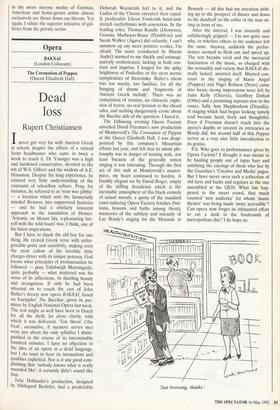ARTS
Exhibitions
The Rural Poetry of Three English Women Artists (Crane Kalman, till 14 June) Romantic Spanish Painting (Long & Ryle, till 6 June)
Rural poetry comes to town
Giles Auty
Any week which combines a first sight, for the year, of house martins in the locali-
ty with the pervasive scent of choisyas in my garden can hardly fail to lift a spirit which events in the art world might occa-
sionally depress. Why do most artists today
turn their backs so contemptuously on the beauty and poetry of the natural environ- ment? I was lucky enough to have spent my childhood in the country at a time when rural children regularly kept jackdaws as pets. One of these resolutely pursued the train which took its young owner to school: a seven-mile journey, morning and evening.
Winifred Nicholson was born in 1893 and died in 1981, a lifetime which witnessed extraordinary changes too in the practice of art. Ben Nicholson, to whom she was married for some part of that span, was a leader of the abstract move- ment in Britain. Winifred was influ- enced by his theories and judgment: they continued to correspond ami- cably even when he had left her for Barbara Hepworth. Winifred Nicholson's art has a selfless kind- ness and innocence which radiates joy. Crane Kalman Gallery first began showing her works in 1967 and was prominent also in estab- lishing early appreciation of artists as disparate as Henry Moore and L.S. Lowry. Mary Potter, another of the artists chosen, was seven years younger than Winifred Nicholson and died in the same year. As with Nicholson, an early marriage — to the humorist Stephen Potter — did not last. The artist used a muted palette to make beautiful still-lifes and sub- tle, silvery evocations of the landscape of East Anglia.
Great gentleness and poetry typify the response of these two and of a younger and 'At Vendome: Bird Flying Urgently', 1991, by Mary Newcomb, 24 x 18 ins, oil on board perhaps stranger artist, Mary Newcomb, who completes the trio. Newcomb's singu- lar work was admired by Winifred Nichol- son and is collected now by a growing band of enthusiasts. The artist immerses herself in the feeling rather than simply appear- ance of her rural subject matter, giving rise to odd and occasionally magical effects. She imagines the secret lives of birds and beasts and opens herself to the atmosphere of natural events. How best can I explain such things? A huge cat belonging to a friend of mine in Norfolk formed a particu- lar attachment to me. My friend's garden adjoined open fields; lying there one sum- mer evening, watching rabbits emerge slowly from surrounding cover, I was joined by my self-appointed companion. The two of us watched the rabbits for some time from roughly the same eye level. After a while, my feline pal could contain himself no longer: as he set off for the evening's hunt, I had the distinct impression he was surprised and disappointed I was not join- ing him.
I hope this rambling explanation may make clearer to others something central in Mary Newcomb's painting. Its world is one of instinctive impression rather than reasoned observation. I hope I shall not incur the wrath of some new gender tribunal by saying that I do not think men could or would have painted any works of the kind on view now at Crane Kalman Gallery. This said, precisely the reverse strikes me as true of four artists whose work constitutes Romantic Spanish Painting at Long & Ryle (4 John Islip Street, SW1). Once again the poetry is predomi- nantly rural, but Manuel Duque and his three younger colleagues from Catalonia strike me as dis- tinctively male in approach and execution. Much of the subject matter is unashamedly romantic, looking back to 18th- and 19th-cen- tury traditions. The titles — such as 'Untitled' — are of this moment, admittedly, yet here too is an exhi- bition which exudes an uncompli- cated, pre-modern joy. Duque
paints the frondiose recesses of forests, from imagination apparent- ly, while his young companions, Oriol Vilapuig, Pablo Aizoiala and Ramiro Fernandez Saus, paint shipwrecks and fountains and flow- ers that seem to have escaped from a Gobelin tapestry. I had a long conversation with Duque in the only language we share, reinforcing . my view that a great deal of excit- ing thinking and painting is taking place in Spain. One would never suppose this from visits to Britain's publicly funded galleries — with the honourable exception of the Museum of Modern Art, Oxford — where- in the more morose modes of German, American and home-grown artists almost exclusively are thrust down our throats. Yet again, I salute the superior initiative of gal- leries from the private sector.



















































 Previous page
Previous page